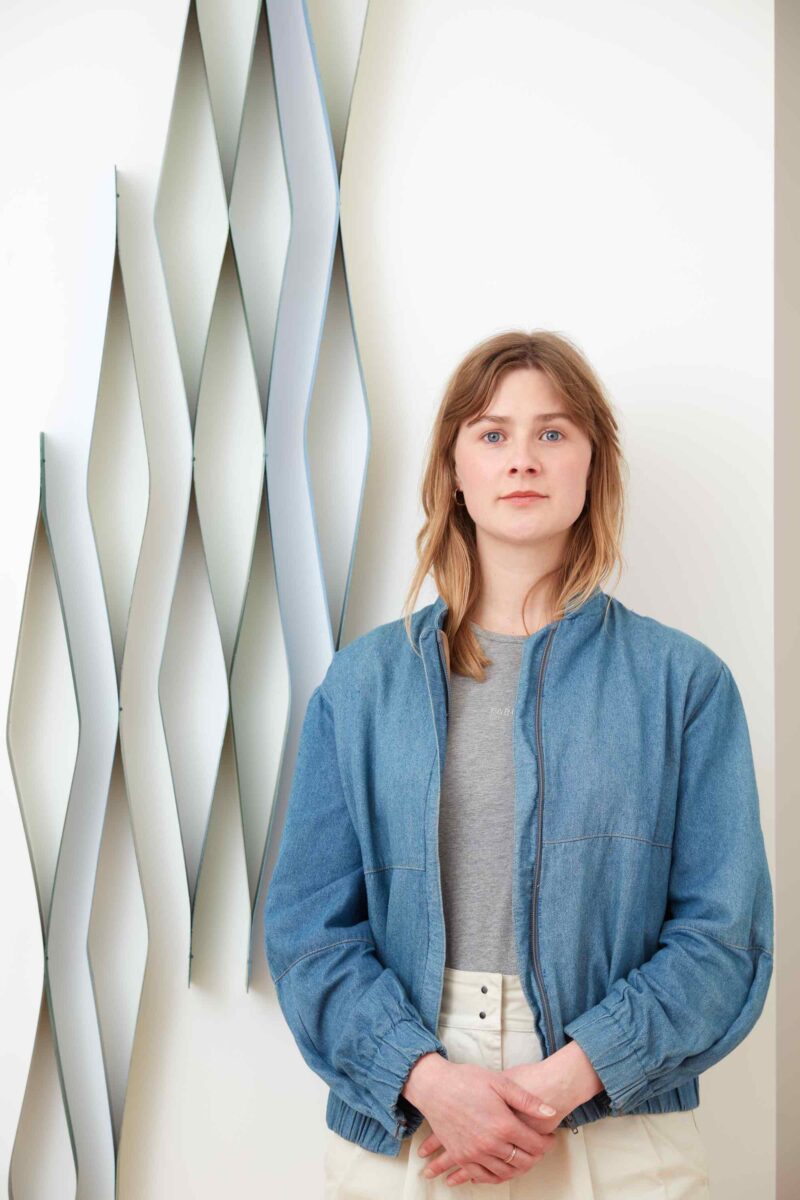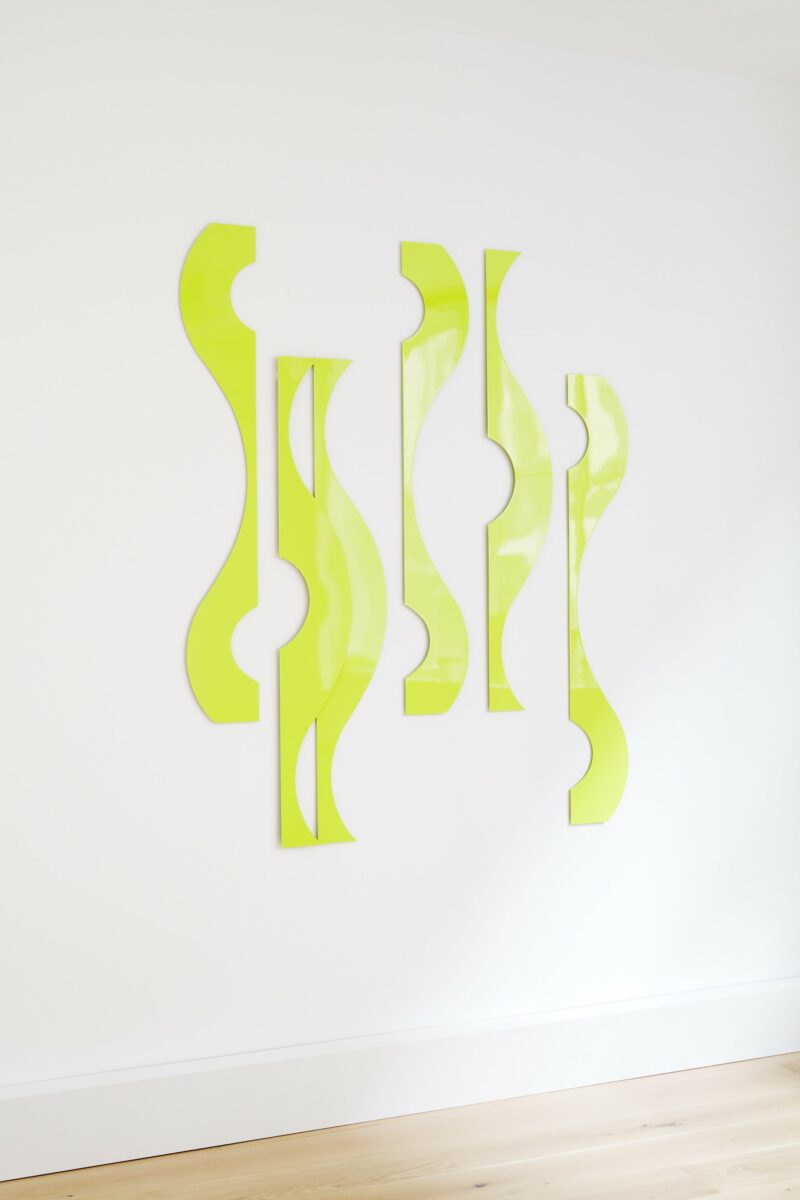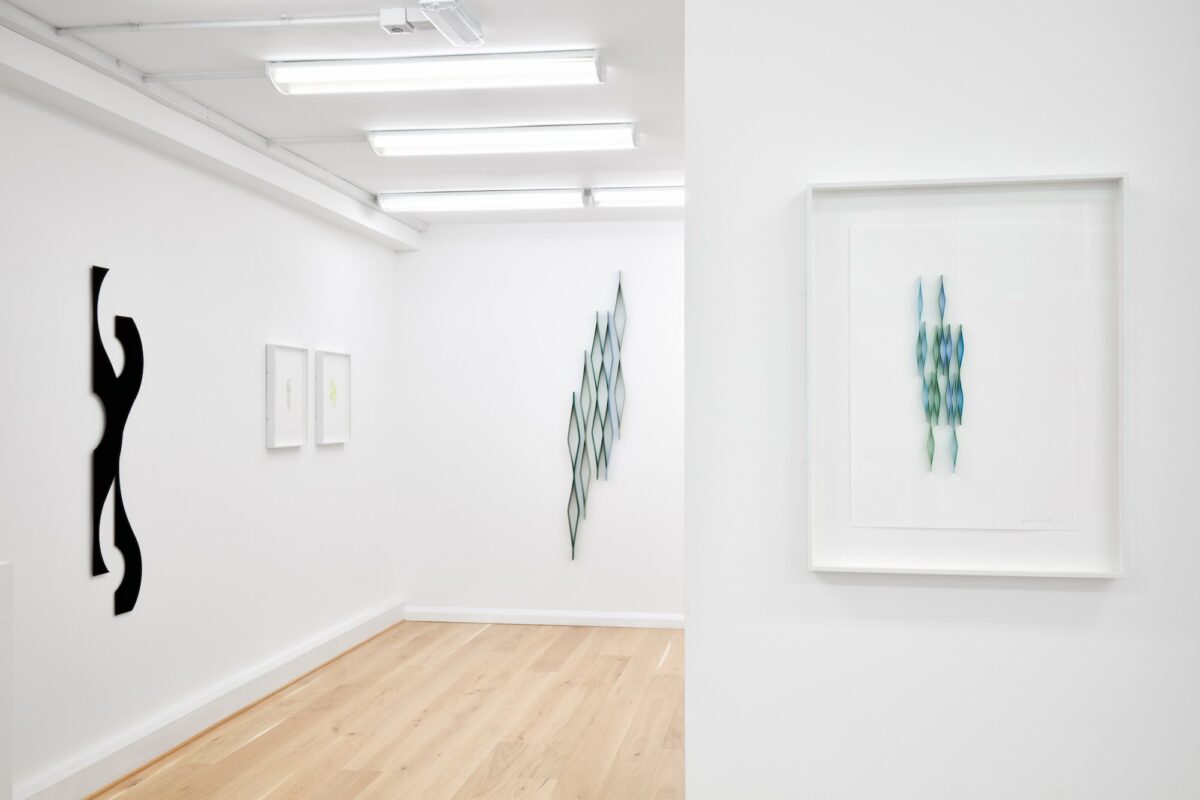Amelia Bowles’ first solo show is at Ione & Mann to 18th April. Her work sits between sculpture, painting and architecture; making use of the activity of light, colour and form, she claims the void and what is immaterial to facilitate the conditions for a series of physiological, cognitive and perceptual encounters. You can read Paul Carey-Kent’s show text on the gallery site. Here he asks about the background to her contemplative and transportative debut.

Your new show ‘Wayfinding’ follows on from the monumentally-scaled installation ‘Weaving With Light’, made across a whole wall of the City & Guilds space last year. That remains relevant: can you describe it?
I became interested in that particular site, whilst at City and Guilds because it was set-back and slightly gloomy, so my challenge was to make a site-responsive piece to illuminate it – to make the light visible. The piece is composed of a series of yellow undulating waves that cast shadows and reveal pockets of light that bathed the wall’s surface and absorbed changes in the temperature of light throughout the day, like a barometer. I am interested in what Monet called the ‘weather effect’; and used the wall as a place to capture the activity of phenomenal and environmental shifts, like his use of the Western Facade of the Rouen Cathedral.

And the light had a particular significance?
Yes… my research into light led to concerns about how we are disconnected from our circadian rhythm system – our body clock. Neurobiological research states that experiencing varying degrees of light and shadow positively impacts that system. What interests me is this internal system regulates our mood and well-being, therefore affecting the way we perceive and interact with the world around us. When surrounded by the colour yellow we release more serotonin, an important neurotransmitter in the day-to-night cycle. The Baroque ideal of the illuminated space beyond demonstrates that we are all heliotropic beings, tracking the movement of the sun.
The yellow work ‘Murmurs (composition I)’, 2024 picks up on those themes in the new show. Are you adjusting the light in the space to maximise those effects?
I’m not playing with the lighting in the space, no, not in the sense that Robert Irwin did, with, for example his early disc paintings; or Mary Corse, who is super-precise about the lighting required for each painting. They’re my heroes, but I’m currently more concerned with how light changes over the course of the day. Murmurs (composition I) is close to the window, and has a mirror finish so that it reflects the changes of light and motion of the city outside; depending on where you stand you will catch glimpses of the various reflections.

How are the other works in ‘Wayfinding’ different?
Each work feeds into the next; for this exhibition, I wanted to work on pieces that don’t solely discuss the importance of light and shadows, but highlight my explorations of spatial relationships, pattern, negative and positive space, blurring the boundaries between what you’re looking at and what you’re not looking at – at how I’m activating those ‘false voids’. I wish to place the audience’s participation at the centre of my work: is it the colours or the shapes between them that become active as you walk around them? I’m interested in making works that you will never see in totality.

Do you see your work as architectural, as well as sculptural and painterly?
Yes… Architectural drawings reference the volumes we inhabit and my works do the same thing; the compositional drawings behind each of my pieces explore the volumes, filled with varying luminosities and coloured surfaces. This is why I’m so drawn to the sculptural relief, as a way to expose the activity taking place within a work. I love the functionality of architectural structures such as the massive wind-catching towers in Iran – used to circulate wind around the building and into big wells of water to cool it down – like natural air conditioning. Fantastic structures are created just to catch the wind.
How do you choose your colours?
I use colour relationships from colours in the same club – attaching and latching onto each other, not colours that will ping against each other. Colour is like an extension of the material, and I like seeing what it does. There’s lots to think about: colour in light and colour in shadow; what it does when it goes on its side; how colours will react to each other; creating different temperatures. In Wayfinding, as my first solo show I wanted to explore the different ways I handle colour and surface.

You seem to favour vertical formats?
I like the figural, human aspect of verticality and by working with multiplicity I am able to distort the individual elements that come together in varying formations, to create something larger and more complex. It plays back to ideas behind the individual and the industry.
What inspires you?
It’s a big question. Laying in the grass on a baking hot hazy day. Waking to see the sun-rise. I have a necessity to be outdoors. Daydreaming, as Bachelard says.
Do human productions also inspire you?
I love diagrams, vents, pylons, sundials, the language of engineering – I’m such a fun person to hang out with! This allows me to think of an artwork as an instrument, or a device to invite something else to take place. I’m interested in the ways we find a visual language or object to explore movement, motion and the passing of time and elements.
And other artists?
I trained as a painter, and I love the history of painting techniques, the illusions of space and how light was considered a material by Vermeer and Turner, for example. There have been some key moments, such as reading the Argentine painter César Paternosto’s brilliant book ‘The Stone and the Thread’ about stone, minimalism, the Incas and the roots of reduction. Or when I saw Robert Irwin’s installation at Dia Beacon as a teenager: that exploded the possibilities of what an artwork could be, how it could have a non-chronological orientation, how your intuition could guide you through the spaces. And I really studied Annie Albers’ weavings and copied her drawings, to see how she creates the patterns and shifts she gets from a grid system.
Why, finally, have you chosen to call the exhibition ‘Wayfinding’?
The word ‘wayfinding’ covers all the ways in which we orient ourselves in physical space and wander from place to place. It is the term for ancient methods of navigation by the stars. It is also, in the modern urban landscape, the signage that helps us navigate – orientate through – parks, business centres, train stations, airports… all the signs and colours that get us from A to B to C and back. These are the symbols that guide and connect us.
Amelia Bowles: Wayfinding – 18th April, Ione & Mann
All images courtesy the artist and Ione & Mann









